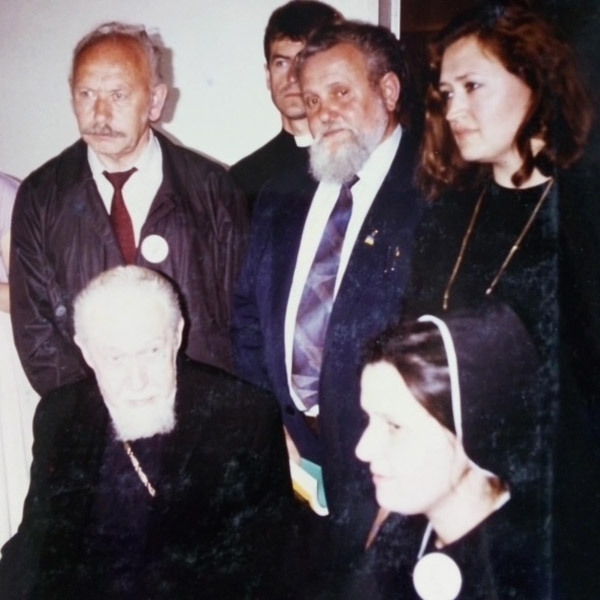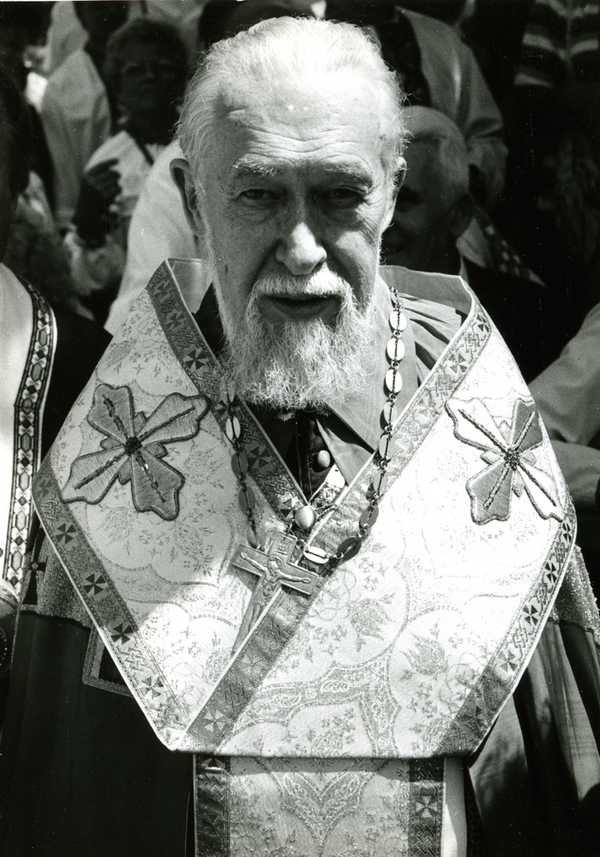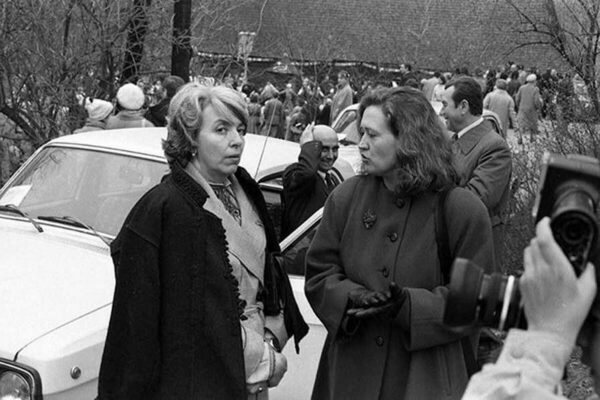
“Our Church and independent Ukraine have developed together” — Sonya Hlutkowsky-Soutus
Sonya Hlutkowsky-Soutus was at the forefront of dramatic changes that swept Ukraine during the collapse of the USSR in 1989. She is someone who not only observed the Ukrainian Greek Catholic Church re-emerge from the underground but who also helped the Church grow and establish itself in a newly independent country. Hlutkowsky-Soutus was the Church’s first press officer, a position she held from 1988 to 1994. During that time, the Church was legalized after decades of persecution by the Soviet authorities. As the USSR fell apart, the Ukrainian Greek Catholic Church established itself as an important institution developing alongside its newly independent nation.
A Ukrainian American, Hlutkowsky-Soutus says that the Church has given her an opportunity to “come to Ukraine, to love Ukraine, and to want to live [in Ukraine].” The Ukrainian Greek Catholic Church was virtually unknown in the world in the late 1980s. Even in Ukraine, the Church was shrouded in mystery. Greek Catholics were persecuted by the Soviet authorities and the Church was banned and liquidated so that it could only exist underground. Crucially, the Church remained a strong force outside of the USSR where it united the Ukrainian diaspora.
A Greek Catholic Press Office

Hlutkowsky-Soutus recalls how she came to her position as the Church’s first press director. “It was 1988, the millennium of Christianity in Ukraine,” she says. “Certainly, it was an environment where there was little awareness about the country. Many Roman Catholic bishops throughout the globe were not aware that there was an underground Catholic Church in Ukraine, or that the Ukrainian Catholic Church in the Soviet Union was the largest outlawed religious body in the world at that time.”
In the late 1980s, the Soviet Union was undergoing perestroyka, a policy of restructuring the federation’s political and economic system led by General Secretary Mikail Gorbachev. This was, in part, an attempt to improve the USSR’s image and it created an opportunity for citizens to demand more human rights and freedoms. It included freedom of worship and legalization of the Church.
Hlutkowsky-Soutus pitched an idea to Robert Moskal and Basil Losten, bishops of the Ukrainian Greek Catholic Church in the U.S., to launch a public relations campaign about the Church. “They agreed to fund a substantial PR campaign, which started in the spring of 1988, just before Ukrainian Catholics were supposed to come to Rome to celebrate the millennium with the Pope [John Paul II],” Sonya recalls. The first step was running a four-page insert in USA Today where they explained the Church’s history and why it looked Orthodox but remained in union with Rome. The Church’s leadership agreed to establish a press office in Rome in order to communicate about the Ukrainian Greek Catholic Church and its faithful and to rebuff derogatory comments coming from the Moscow Patriarchate, the seat of the primate of the Russian Orthodox Church.
It was at this point that Hlutkowsky-Soutus took up the role of press officer for the Ukrainian Catholic Church in Rome under the direction of His Beatitude Myroslav Ivan Cardinal Lubachivsky. Together with Cardinal Lubachivsky's staff, they reached out to Andrei Sakharov, a famous dissident and a Nobel laureate in physics who was allowed to leave the USSR. In the early 1980s, Sakharov was under surveillance in internal exile by the KGB, so his permission to travel was a strategic move by Gorbachev to highlight how the Soviet Union was becoming more open under glasnost (a policy of more transparency and openness in government) and perestroyka.

Sakharov was traveling to Rome, and Hlutkowsky-Soutus and Fr. Iwan Dacko, the chancellor of Lviv Archeparchy (then in exile in Rome) asked him to meet with Cardinal Myroslav Ivan Liubachivskyi, then head of the Greek Catholic Church. “Even though Sakharov was a Russian and an atheist, he was a well-known person in the human rights space,” Hlutkowsky-Soutus recalls. “He did a press conference with His Beatitude Myroslav Ivan where he spoke about the violations of human rights of the Ukrainian Catholics.” This was a powerful start to a year-long campaign that helped the Church establish stronger communication with the underground in Ukraine and put greater pressure on Gorbachev to make concessions on freedom of worship.
In another attempt to put public pressure on the Soviet government, the Church leadership embarked on a European tour in anticipation of meetings between Gorbachev and several European leaders. In 1989, the General Secretary stepped up his visits to Western European countries on a mission to convince the West that there was nothing to fear from the USSR. The Church leaders visited every country on Gorbachev’s itinerary a few weeks in advance of the Soviet leader. “For example, His Beatitude Myroslav Ivan went to France and met with Cardinal Lustiger, the Archbishop of Paris,” Hlutkowsky-Soutus recalls. “The cardinals then went to the Ministry of Foreign Affairs and asked them to raise the issue of the Ukrainian Catholic Church and the human rights of Ukrainian Catholics as some of the main discussion topics with Gorbachev.”
In this way, the Church was working toward its objective: decriminalizing Greek Catholicism in Ukraine. “Our goal was that by the time Gorbachev would come to see Pope John Paul II on December 1, 1989, that he would declare that the Ukrainian Catholic Church was legalized,” Hlutkowsky-Soutus says. “And that’s, indeed, what happened.”
Emerging from the Underground
On November 20, 1989, Soviet leadership granted permission for groups of twenty or more Ukrainian Catholics to form parishes, and by 1990, the Church in Ukraine began emerging from the underground. According to Hlutkowsky-Soutus, these were challenging years as Ukrainian Catholics re-established their church. “It was quite a tumultuous time,” she recalls, “but it was also incredibly hopeful, and the Church had great moral authority.” The Church was always perceived as a Church of the martyrs and the underground because it always opposed the regime and supported Ukraine’s project of nation-building.
“We were in the underground, persecuted. We were unable to live a true authentic life as a church in the same way that Ukrainians were not able to live true authentic lives.”

In 1991, the August coup took place in Moscow when Soviet hard-liners, opposed to Gorbachev’s reforms, tried to remove him from power. While the coup failed and his power was restored, Gorbachev had lost most of his influence and his days in office were numbered. Afterwards, Ukrainians were fearful about the future of their country. The government approached Cardinal Myroslav Ivan and advised him to return to Rome for safety reasons. He refused, saying that the Church had to stay with its people. “That was a huge moment of great courage,” says Hlutkowsky-Soutus. “Our Church and independent Ukraine have developed together,” she explains. “We were in the underground, persecuted. We were unable to live a true authentic life as a church in the same way that Ukrainians were not able to live true authentic lives.”
Hlutkowsky-Soutus says that because the Church had to rebuild everything in the 1990s, it was able to do so in a much more contemporary way—such as contributing to the development of a modern university or supporting ethical business development. In a short space of time, it built a seminary, a Ukrainian Catholic University, and started developing other social-outreach programs.
In the summer of 1991, President of Ukraine Leonid Kravchuk invited the Church’s leadership to the capital and suggested Church leaders celebrate their liturgy at the Church of St. Andrew, originally an Orthodox Church but then a museum. The city was home to many Greek Catholics who, due to years of persecution, had nowhere to worship. When Ukrainian Catholics attempted to enter the church they were blocked by a crowd of Russian Orthodox faithful. Myroslav Ivan called upon the Greek Catholics to leave peacefully and resist the temptation to respond with violence. Overall, the early-1990s were marked by conflicts between the faithful of the Russian Orthodox Church in Ukraine and the faithful of other churches.
Church leaders celebrated the liturgy that day outside a chapel on the grounds of a psychiatric hospital on one side and medical waste containers on the other. It was far from ideal, but Myroslav Ivan’s reaction was stoic: “This is not what we had hoped for, but we know that today we are still able to have a liturgy in Kyiv, and let us be grateful for that.” In 2002, the Church was able to begin construction on the Cathedral of the Resurrection of Christ on a site on the Left Bank of the city. Now the main temple, it opened in 2011.
“The story of our Church and the humanity it embodies made me really want to be a part of it,” Hlutkowsky-Soutus concludes. “I am not going to say that the Church had the most important role [in Ukraine’s democratic transformation]. Without the will of its people, the Church would not be able to guide them. The people wanted the Church’s leadership, they had a thirst for moral guidance, and the Church was able to provide it to them.”

About the Author
Anna Romandash is a Master of Global Affairs student in the Keough School of Global Affairs, majoring in International Peace Studies. She is an award-winning journalist from Ukraine, who has worked as a reporter and digital policy expert focusing on sustainable media development, human rights, and information access. Romandash was named Media Freedom Ambassador of Ukraine for her human rights and media work and is the recipient of a Kroc Institute Fellowship.
Originally published by at crossingthesquare.nd.edu on October 21, 2021.